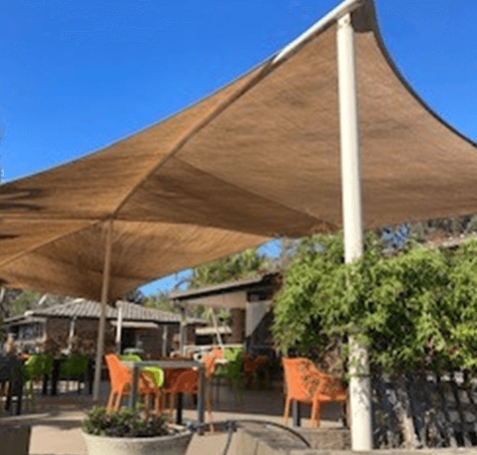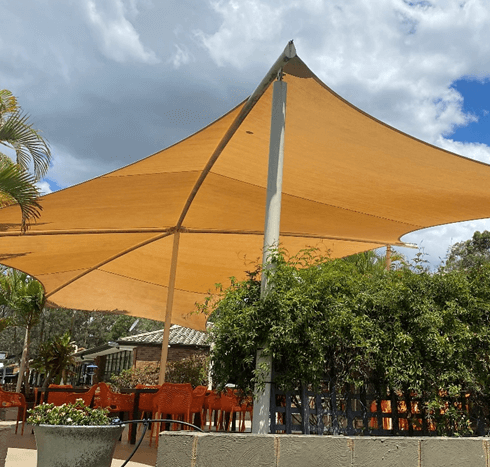Nothing beats the comfort of enjoying the outdoors under a good shade sail. Shade sails provide the best cover from harsh weather elements like the sun. However, while offering this protection, they’re prone to quick and severe damage if not well maintained. This article delves into the factors influencing shade sail longevity and how to maintain their vibrancy.
The importance of shade sails
Shade sails play a vital role in safeguarding against extreme heat and harmful UV rays, preventing skin damage and reducing the risk of skin cancer. They also create more relaxed outdoor environments, especially in hot climates, enabling comfortable outdoor activities.
These structures also contribute to energy conservation by reducing the need for air conditioning. They do this indirectly by mitigating solar heat and creating cooler outdoor environments. By blocking direct sunlight and lowering surface temperatures, they encourage outdoor activities and decrease reliance on air conditioning, leading to energy savings and promoting a more sustainable approach to cooling.
Lastly, shade sails enhance the aesthetic appeal of outdoor spaces, making them more inviting and versatile for various functions.
Shade sails maintenance
You won’t be able to enjoy the benefits mentioned above if your shade sails aren’t in good shape. Regular maintenance, including cleaning and inspection for wear and tear, is crucial for ensuring the longevity and effectiveness of shade sails. Many homeowners hire the services of expert shade sail cleaners for this task.
Timely repairs can prevent minor issues from escalating, saving costs in the long run. Proper installation, tensioning, and usage are also pivotal factors that influence the durability of shade sails. Avoiding excessive pulling or hanging heavy items prevents strain on the fabric and attachment points, ensuring the sails’ longevity.
Life expectancy of shade sails
The life expectancy of a shade sail can vary widely depending on several factors, including material quality, UV exposure, wind and weather conditions, maintenance, installation, and usage.
Generally, high-quality shade cloth made from durable materials such as high-density polyethene (HDPE) or commercial-grade fabric can last 5 to 15 years depending on the fabric or even longer with proper care and maintenance. Check your cloth choice’s warranty for expected life span under normal conditions if maintained.
Meanwhile, shade sails made from high-quality, UV-resistant materials tend to last longer. Cheaper materials may deteriorate more quickly due to exposure to sunlight, fresh water, and other environmental elements.
To add to this, prolonged exposure to sunlight and UV rays can cause the cloth of the shade sail to weaken over time. UV-resistant materials are designed to withstand this, but constant intense sunlight can still impact their longevity.
Living in an area with high wind loads or frequent severe weather conditions can stress the shade sail more. Proper installation and tensioning are crucial to shade sail maintenance and ensure the structure can withstand these conditions.
Another factor that influences lifespan is shade sail cleaning. If you consistently wash the shade sail and inspect it for signs of deterioration, you can extend its lifespan. Regular cleaning and correct tensioning prevent wear and tear, preserving the shade sail’s longevity.
Installing a shade sail correctly extends its lifespan by ensuring even tautness and reducing stress on the cloth and anchor points. Securely anchored residential shade sails are less prone to sagging or damage during high winds, increasing their durability and ensuring they stay in top condition.
Finally, proper usage, such as avoiding excessive pulling or hanging heavy items, prevents strain on the shade sail cloth and attachment points, ensuring longevity. Following care guidelines, like removing snow, dirt, or debris promptly, also prevents damage.
It’s essential to choose a high-quality product, follow the manufacturer’s guidelines for installation, maintenance and cleaning, and consider taking it down during harsh weather conditions if possible. Regular inspections can help identify issues early, allowing for timely repairs or replacements.
Cleaning your shade sails


The frequency of shade sail cleaning depends on the local environmental conditions. Generally, getting a cleaning service at least once a year is advisable to remove accumulated dirt, dust, animal droppings, mildew, and other debris.
However, if you live in an area with high pollution, near the coast, or under trees that shed a lot of sap or leaves, more frequent shade sail cleaning may be necessary. Regular rinsing with water, a soft brush, and mild soap, followed by a thorough rinse and proper air drying, can help maintain the fabric’s integrity and extend its lifespan.
Additionally, promptly calling cleaning services and addressing any stains or spills can prevent them from becoming permanent, making it easier to clean the shade sail effectively.
Can you power wash shade sails safely?
High-pressure hose washing can damage the material if not done correctly by potentially causing it to stretch, rip and cause your stitching to come apart. Using cleaners not of a neutral Ph will cause the cloth to lose its protective coatings and may strip away any UV-resistant layers that protect the material from sun damage.
It’s best to hire a cleaning service that uses a gentler approach and reduce the chance of any damage being caused to your sail.
Can you leave shade sails up all year?
Shade sails can be left up year-round in mild climates but should be removed during severe weather conditions like when severe weather warnings are issued to prevent damage. Regular inspections, regardless of temperature, are essential.
Checking tension, anchor points, and fabric for deterioration enables timely repairs, ensuring the sails’ longevity and aesthetic appeal.
How do I keep my sunshade sail from sagging?
Proper installation is critical to preventing sagging. Tension the sails tightly and use durable materials for fabric and supporting hardware. Turnbuckles or tensioning devices at anchor points allow adjustments as the material naturally stretches. Routine cleaning services and maintenance using professional techniques help maintain optimum tension and prevent sagging over time.
By proactively managing tension during installation and conducting routine cleaning and maintenance, you can effectively prevent sagging and ensure the longevity of your sunshade sails.
Maintaining vibrancy
The longevity of shade sail colour varies depending on factors like UV exposure, material quality, and maintenance. High-quality UV-resistant fabrics maintain colour vibrancy for 5 to 12 years, with proper care and limited exposure to harsh sunlight.
Choosing UV-resistant material and regular cleaning with mild soap and water is vital to maintaining your shade sails’ vibrancy. Applying fabric protectant spray with UV inhibitors enhances colour retention, ensuring the sails stay vibrant and appealing for an extended period.
Conclusion
Ensuring the longevity and vibrancy of shade sails involves thoughtful installation, vigilant usage, and regular upkeep and cleaning. By choosing high-quality materials, providing proper tension, and conducting routine cleaning and inspections, these outdoor features can endure various weather conditions and retain their vibrance over time. Enjoy the aesthetic appeal and functional benefits of shade sails for years, making them a valuable addition to any property.

